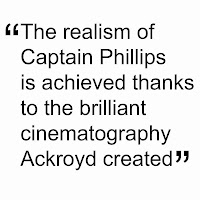Captain Phillips is a film based on a true story directed by Paul Greengrass (The Bourne Ultimatum, The Bourne Supremacy, United 93) with Tom Hanks playing the role of the captain.
The plot. Failing to hijack an US flagged ship, 4 Somali pirates kidnap her captain, Rich Phillips, asking for ransom. Us Navy intervenes in rescuing him.
Camera: Arriflex 435 and 235, Aaton Penelope and XTR Prod, Arri Alexa, Canon Eos C300
Lenses: Angenieux Optimo
Aspect ratio: 2.35:1
Format: 35mm, 16mm, ARRIRAW
Film Stock: Fuji Eterna 8663 250D, Fuji Eterna 8673 500T, Fuji Eterna 8563 250D, Fuji Eterna 8573 500T
The cinematography of Captain Phillips is signed by Greengrass' usual DP, Danny Akroyd (Green Zone, United 93, The Hurt Locker, Looking for Eric); his choice for the film stock is justified for the texture and the reality he was after, characteristics that, according to him, digital doesn't offer as much as film does.
The sense of reality is the first thing we notice from the very beginning of the film. Audience is thrown into the story thanks to the way of shooting which has all the characteristics of documentaries: the hand-held camera is constantly looking for action or motions, panning and shifting rapidly, shaking, re-framing, following the characters... Even long zoom is used in this sense: as in a docufilm or a tv reality, the focal length is changed quickly closing up to characters.
Multiple camera shooting and improvisation were necessary to ensure a better sense of realism (apparently Tom Hanks and the actors who played the roles of the pirates didn't meet till the day of shooting to create a certain tension in the scene...). But the realism is also achieved thanks to camera shots used: there's a clear preference for close ups which, along with the way the story is told, makes us feel close to characters and feel respect for them; for example, we never consider most of the pirates as bad.
Close up and extreme close up shots are also used at the beginning of the film to introduce the character Tom Hanks plays and empathise with him.
 The way of lighting is as natural as possible, along with the general feel of realism of the film. Artificial lights are reinforced and softened but there's not a specific regard for exposure: characters, when moving, easily fall into sub-exposure or overexposure which, obviously helps with the purpose of the film.
The way of lighting is as natural as possible, along with the general feel of realism of the film. Artificial lights are reinforced and softened but there's not a specific regard for exposure: characters, when moving, easily fall into sub-exposure or overexposure which, obviously helps with the purpose of the film.
There's a clear difference in texture, grain and colours depending on which characters camera is following. Tom Hanks and his crew are shot on 35mm, with perfectly balanced and vivid colours and a nice colour palette; the image is neat and organic.The pirates are shot on 16mm: the image is very grainy, the look is "dirty" with lots of flares easily visible and tones are are quite warm. The US Navy is shot on digital: the image is very neat and no grain is present, a blue tone and desaturated colours make everything cold and formal. Regardless if this is an easy and far too obvious solution, it works.
Captain Phillips is a very suspenseful film in which a story unfolds to the audience with great realism thanks to the good work director Paul Greengrass and cinematographer Barry Ackroyd did together.
Nice review!
ReplyDeleteNice review as the HD video. arri alexas
ReplyDelete